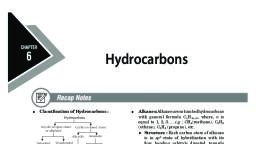Page 1 :
MSc(Chem) Ist Sem, , Dr Sanjeev Kumar Jha, , Non-benzenoid aromatic compounds, A compound which exhibits an aromatic behaviour but does not contain, any benzene nucleus . The non benzenoid aromatic compound have one, or more rings fused but none of the rings is a benzene ring . The ring might, contain 7 , 5 etc number of carbons but that ring will not be a benzene ring ., The most basic example of non benzenoid aromatic compound is, AZULENE . It is a system of two fused rings , one containing 7 and the, other 5 carbons ., , Azulene, which has a specific structure of ring-fused unsaturated sevenmembered and five-membered rings, is a typical non-benzenoid aromatic, compound. Whereas naphthalene or other hydrocarbon compounds are, generally colorless, azulene, a structural isomer of naphthalene, is dark, blue, and the name comes from the Spanish word azul, meaning "blue".
Page 2 :
There are few conjugated monocyclic and poly cyclic systems which, contains (4n+2) numbers of delocalized π electrons and not benzenoid are, known as non-benzenoid aromatic compounds., Huckel’s rule predicts the [14] [18] and [22] annulene with (4n+2) π, electrons when n= 3 ,4, 5 respectively have been found to be aromatic., , Alternant and Nonalternant Hydrocarbons, Aromatic hydrocarbons can be divided into alternant and nonalternant, hydrocarbons. In alternant hydrocarbons, the conjugated carbon atoms can, be divided into two sets such that no two atoms of the same set are directly, linked. For convenience, one set may be starred. Naphthalene is an, alternant and azulene a nonalternant hydrocarbon:, , In alternant hydrocarbons, the bonding and antibonding orbitals occur in, pairs; that is, for every bonding orbital with an energy –E there is an, antibonding one with energy +E .Even-alternant hydrocarbons are those
Page 3 :
with an even number of conjugated atoms, that is, an equal number of, starred and unstarred atoms. For these hydrocarbons all the bonding, orbitals are filled and the electrons are uniformly spread over the, unsaturated atoms. For nonalternant hydrocarbons, the energies of, , the bonding and antibonding orbitals are not equal and opposite, and charge distributions are not the same in cations, anions, and, radicals., , Huckel's Rule, In 1931, German chemist and physicist Erich Hückel proposed a theory to, help determine if a planar ring molecule would have aromatic properties., His rule states that if a cyclic, planar molecule has 4n+2 π electrons, it is, considered aromatic. This rule would come to be known as Hückel's Rule., Four Criteria for Aromaticity, When deciding if a compound is aromatic, go through the following, checklist. If the compound does not meet all the following criteria, it is likely, not aromatic., 1. The molecule, 2. The molecule, plane), 3. The molecule, 4. The molecule, , is cyclic (a ring of atoms), is planar (all atoms in the molecule lie in the same, is fully conjugated (p orbitals at every atom in the ring), has 4n+2 π electrons (n=0 or any positive integer), , Why 4n+2 π Electrons?
Page 4 :
According to Hückel's Molecular Orbital Theory, a compound is particularly, stable if all of its bonding molecular orbitals are filled with paired electrons., This is true of aromatic compounds, meaning they are quite stable. With, aromatic compounds, 2 electrons fill the lowest energy molecular orbital,, and 4 electrons fill each subsequent energy level (the number of, subsequent energy levels is denoted by n), leaving all bonding orbitals filled, and, , no, , anti-bonding, , orbitals, , occupied., , This, , gives, , a, , total, , of, , 4n+2 ππ electrons. We can see how this works with the molecular orbital, diagram for the aromatic compound, benzene, below. Benzene has, 6 ππ electrons. Its first 2 ππ electrons fill the lowest energy orbital, and it, has 4 ππ electrons remaining. These 4 fill in the orbitals of the succeeding, energy level. Notice how all of its bonding orbitals are filled, but none of the, anti-bonding orbitals have any electrons., , To apply the 4n+2 rule, first count the number of π electrons in the, molecule. Then, set this number equal to 4n+2 and solve for n. If is 0 or
Page 5 :
any positive integer (1, 2, 3,...), the rule has been met. For example,, benzene has six π electrons:, (4n+2)π=6, For benzene, we find that n=1, which is a positive integer, so the rule is, met.








































































